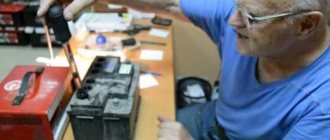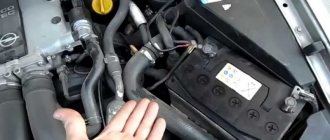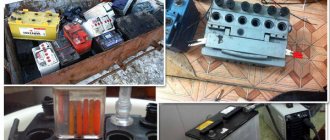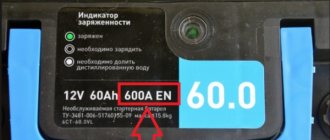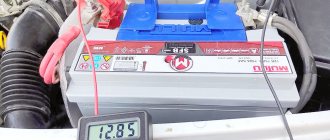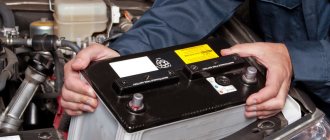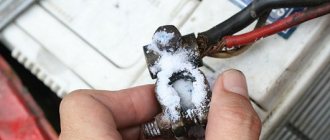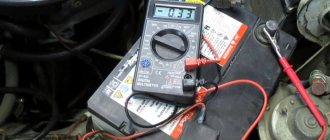The degree of charge of a battery by voltage can be characterized as the “force” of charged particles that is transmitted by a source of electrical energy through a cable. In this case, thanks to these charged particles, the machine’s devices are powered. Voltage as a value is not a constant and tends to change in correlation with the battery charge value.
Battery charge level by voltage table
| Battery charge level, % | Voltage (no load), V |
| 100 | 12,66 |
| 94 | 12,60 |
| 87,5 | 12,54 |
| 81 | 12,48 |
| 75 | 12,42 |
| 69 | 12,36 |
| 62,5 | 12,30 |
| 56 | 12,24 |
| 50 | 12,18 |
| 44 | 12,12 |
| 37,5 | 12,06 |
| 31 | 12,00 |
| 25 | 11,94 |
| 19 | 11,88 |
| 12,56 | 11,82 |
| 6 | 11,76 |
| 0 | 11,70 |
The battery is recharged using a separate charging unit, which is designed for acid-acid machine batteries. The most basic charging functionalities of this type consist of a current transformer and a diode bridge.
Thanks to these components, the alternating voltage goes to the memory, where it is transformed into a direct voltage (15V). This value is enough to recharge the car battery.
Some charger models include current and voltage indicators and adjust them accordingly. There are also devices that adjust these parameters automatically. And the most basic charger models do not include indicators or adjustments.
How to check if the battery is alive in a car without instruments?
Battery indicator
It is quite easy to determine the condition of the battery in a car without special instruments. There are several ways to do this.
Modern batteries have a special charge indicator, usually in the form of a round window. You can determine the charge by the color of this indicator. Next to such an indicator on the battery there is always a decoding indicating which color corresponds to a particular charge level. Green - full charge; gray - half charge; red or black - full discharge.
In the absence of such an indicator, you can use two methods. The first is using headlights. The cooled engine is started and the low beam is turned on. If the light does not dim during 5 minutes of operation, then everything is normal.
The second (also when cold) is to turn on the ignition, wait a minute, and then press the signal several times. With a “live” battery, the beep sound will be loud and continuous.
What parameters to consider when charging a battery?
When charging a car battery yourself, it is worth considering a number of fundamental parameters:
- The suitable current for charging is 10% of the designated capacity of the car battery. For example, the capacity of your battery is 80Ah, in this case the charging current will remain at 8A.
- The voltage at the charging unit terminals should be 10% higher than the battery voltage. When the voltage at the terminals of a 100% charged battery corresponds to 12.6V, at the contacts of the charger this value should be in the range of 13.86V.
- You can reproduce the battery charging more quickly; for this, the current strength increases to 20-30A. However, such recharging is not recommended by professional car owners, as it negatively affects the life of the battery.
- When charging a helium battery, it is forbidden to go beyond the voltage limit of 14.2V, since in this case this value is the critical point for this type of battery.
Correct battery charging
Many car enthusiasts charge an acid battery at home. This process requires certain conditions to be met to ensure safety.
Before the initial stage, you need to make sure that the battery is intact and that the battery does not have a charge. To do this, before the process, make a visual inspection to ensure that there are no flaws in the battery case.
If you find damage, this may mean that the electrolyte has leaked, and such a battery cannot be repaired or restored. The working battery also needs to be freed from dirt, dust and deposits. This can be done using a damp sponge dipped in soapy water. Additionally, the ventilation in the battery cover must be cleaned.
Some batteries contain indicators; a sticker for the meaning of these designations is usually located on the battery cover. Such an indicator can show the electrolyte boundaries, electrolyte density and battery charge level. Additionally, the battery can be tested on the clamps. When the battery is empty, the voltage will show a value lower than that established by the standards.
Do not forget to check the electrolyte boundaries before the work process. To do this, you need to unscrew the tops on the battery banks (you can do it manually). The electrolyte must be pure, homogeneous and completely cover the plates. If the amount of electrolyte is insufficient, you need to add distilled water to the electrolyte manually.
Electrolyte
There is another way to check the charge of a car battery with your own hands. It is especially relevant on the eve of winter. As is known, with a drop in temperature, the density of the electrolyte decreases. Accordingly, the charge and performance of the battery decreases. How to check the charge of a car battery? For this we need a hydrometer. Below are detailed instructions:
- So, open the hood and, using a negative screwdriver, unscrew the battery “banks” one by one. There are only 6 of them.
- We immerse our hydrometer inside and wait until it is filled with electrolyte.
- Next, we take the device out and look at the readings.
- After a short time, the float will float to the desired level. There will be several divisions on the scale. A figure of 1.23-1.27 grams per cubic centimeter is considered normal. If the electrolyte density is 1.2 grams, then the battery is about a quarter discharged. A deep discharge is indicated by a reading of 1.1 or less grams per cubic centimeter.
It is also worth checking the electrolyte level itself in each of the “cans”. If it is insufficient, it should be renewed. This can be done with distilled water (coolant is also diluted with it).
Battery charging methods
It is better to recharge the battery in special, well-ventilated rooms. Since the electrolyte evaporates and harmful vapors are released into the air.
To begin with, charging functionality is attached to the battery, and only after that the power from the network is connected. Otherwise, the charging fuses may be damaged.
Battery charging is carried out in three ways:
- The first type of charge involves maintaining a voltage at the border of 16V for a 12-volt battery, varying the current strength. In the early stages of charging, it stays at 20-30A, but then gradually drops as charging progresses. This process usually occurs within 24 hours; the lower the voltage, the longer the recharging time will be. It is not recommended to use high voltage.
- The second type is radically contrasting - the current strength here is a constant value, and the variable value is voltage. This is a more extreme type of charging and requires a professional approach.
- The third type involves a combination of the first two. That is, first charging is carried out using direct current, and then using constant voltage.
At the end of the process, the voltage at the battery terminals is tested. This is done with the operation of a load fork. Or the battery is installed in the car for testing. If the battery is charged, the starter will start without any problems.
Analysis of the causes of battery discharge
With regular use of the vehicle, preventive inspections of the battery and checks of the functionality of the generator, special charging of the battery is not required. It is necessary to charge a car battery due to improper use, in case of complete discharge (for example, when electrical appliances are not turned off) or seasonal maintenance.
A charged battery may quickly lose charge. The reasons for this situation are as follows:
- The battery has expired and needs to be replaced.
- The generator that charges the battery during vehicle operation has failed.
- Current leakage in the vehicle electrical network.
- Malfunction of electricity consumers (radio, alarm, electric power steering, lighting and information devices, etc.).
To solve the problem of rapid battery discharge, it is necessary to identify and fix the problem by conducting a technical inspection of the car.
How long to charge a lead acid battery
The battery is perceived to be fully charged when the electrolyte begins to boil. The average charging time is usually 9 hours for standard batteries. But this indicator varies depending on the type of battery and its charge level at the time the charging process begins.
It is not recommended to recharge the battery, as this will cause scale to form on the lead plate. After which the battery may deteriorate beyond repair. In order to avoid this, you need to test the height of the electrolyte and its density before starting the process, especially in the cool season.
At high air temperatures, the battery is charged at a capacity reading of 50%; at colder temperatures, this figure is usually 25%.
The battery should be cleaned of dirt, dust and scale not only before charging, but also after, since traces of acid may remain on the surface during the charging process.
You can clean the battery with soap or soda solution. This procedure should be carried out with gloves for safety reasons. At the same time, try not to let the solution leak into the battery jars.
The whole process is quite simple, and if you follow all the instructions, the battery will last a long time and work well.
Check during operation
During operation, it is necessary to periodically check the performance of the battery. Here you should take into account the fact that if you turn off the engine and immediately take measurements, the result will always be the same - the battery is normal. For reliability, measurements must be taken 6-7 hours after stopping the engine. This is due to the fact that during operation of the generator, the electrolyte inside the battery heats up and therefore its density increases, thereby increasing the voltage at its terminals.
In addition, if the battery is not new, but has been used for several years, it has a certain self-discharge current, which will be compensated by recharging the generator. To reduce natural loss of capacity, keep the battery clean. If there are traces of electrolyte and other wet contaminants on it, the discharge current can flow from the positive terminal to the car body.
Another nuance is that the battery is connected to the on-board network, which, even when the ignition switch is turned off, consumes a certain amount of electricity (radio, alarm, etc.). Therefore, it is necessary to remove the ground terminal going from the car body to the negative terminal before taking measurements, otherwise a certain error will appear.
How to test your battery charge level
Battery endurance is characterized by voltage; this data is fundamental for measuring the battery charge level.
The voltage can be tested in two ways: by measuring the readings at the terminals and by measuring the density of the electrolyte.
Terminal readings
This is the simplest and most accessible method. It focuses on the indicator values that are measured at the battery contacts with a voltmeter - a special measuring device. It will show the exact value, down to hundredths of a volt.
To take measurements, the battery must be at rest for 4-5 hours, and only after that can measurements be taken. The usual voltage level for acid batteries is 12.5-12.9V. For more accurate measurements, refer to the above table.
There is a method for measuring with higher accuracy using special memories with memory and a microprocessor. They have the ability to track several series of battery charge and discharge.
This method is as accurate as possible, and this way you can save money when servicing your battery.
Electrolyte density
The second method is to measure the density of the liquid electrolyte. Accordingly, this method is only suitable for batteries with electrolyte. The electrolyte consists of 65% distillate and 35% sulfuric acid.
When the battery is discharged, the density of sulfuric acid decreases. The higher the discharge, the more the density decreases. These coefficients are in constant relationship.
You can measure the density of the electrolyte with a special device - a hydrometer. With a fully charged battery of 12.7V and average air temperature, the density of the electrolyte will fluctuate between 1.27-1.28 g/cm3.
There is a special data table showing the dependence of battery charge on electrolyte density:
| Charge degree, % | Electrolyte density, g/cm3 |
| 10 | 1,13 |
| 20 | 1,14 |
| 30 | 1,16 |
| 40 | 1,17 |
| 50 | 1,19 |
| 60 | 1,20 |
| 70 | 1,21 |
| 80 | 1,23 |
| 90 | 1,24 |
| 95 | 1,25 |
| 100 | 1,27-1,28 |
The higher the density of the electrolyte, the more resistant the battery will remain in cold mode. In regions with cold climatic conditions, the electrolyte density is forcibly increased to 1.30 g/cm3.
However, the maximum permissible value is 1.35 g/cm3, otherwise the acid may melt the plates.
Battery voltage
First, let’s look at the meaning of the term “tension.” Essentially, it is the “pressure” of charged electrons created by a current source through a circuit (wire). Electrons perform useful work (powering light bulbs, equipment, etc.). Voltage is measured in Volts.
Measuring battery voltage
You can use a multimeter to measure battery voltage. The contact probes of the device are applied to the battery terminals. Formally, a voltage of 12V is considered normal. The actual battery voltage should be between 12.6V -12.7V. These are the indicators for a fully charged battery.
These values may vary depending on environmental conditions and test time. Immediately after charging, the device may show 13V - 13.2V. Although such values are also considered acceptable. To get the correct data, you need to wait an hour or two after charging.
If the voltage drops below 12 Volts, this indicates a low battery. The voltage value and charge level can be compared using the following table.
| Voltage, Volt | Charge degree, % |
| 12,6 + | 100 |
| 12,5 | 90 |
| 12,42 | 80 |
| 12,32 | 70 |
| 12,20 | 60 |
| 12,06 | 50 |
| 11,9 | 40 |
| 11,75 | 30 |
| 11,58 | 20 |
| 11,31 | 10 |
| 10,5 | 0 |
As can be seen from the table, a voltage below 12V indicates a 50% discharge of the battery. The battery needs urgent recharging. You should know that during the discharge process a process of sulfation of the plates occurs. The density of the electrolyte decreases. Sulfuric acid breaks down by participating in a chemical reaction. Lead sulfate forms on the plates. Timely charging starts this process in the opposite direction. If you allow a deep discharge, it will be difficult to revive the battery. It will either fail completely or significantly lose capacity.
The minimum voltage at which the battery can operate is considered to be 11.9 Volts.
Measurements under load
Sometimes the battery has the ability to start the engine even when the voltage drops. But it is important that after starting the generator provides its further charge.
During the ignition process, the charge in the battery goes to the starter, as a high current is supplied. With a well-functioning battery, battery restoration is completed in 5 seconds.
The voltage on a well-functioning battery is in the range of 12.6-12.9V. But these data do not always correctly assess the condition of the battery. An effect can occur when in a quiet state the voltage in the battery is good, but under the influence of a load it drops sharply, and the charge runs out quickly.
Therefore, it makes sense to sometimes take measurements under load. To do this, use a loading fork. This helps you understand how well the battery holds its charge.
The plug is a device with a load spiral, contact probes and a voltmeter. The device creates an imitation of starting current, while producing a voltage that is 2 times higher than the battery capacity.
With a battery capacity of 50 Ah, a load of up to 100A occurs. Such measurements are made on a fully charged battery. After 5 seconds the device produces the result.
Considering that the load voltage indicator is less, with a working battery this indicator will be 10V, and with a poorly functioning battery it will be 9V or less.
Load fork
This is perhaps the most professional way to check the condition of the battery. Typically this method is used at service stations. What is its essence? The device is connected to the battery terminals and provides short circuit current.
That is, the load fork simulates the operation of the starter and shows how many volts the battery drops when the driver tries to start the engine. To date, this is the most accurate scheme for checking the condition of the battery. To read the readings correctly, remember that after loading the battery voltage must be at least 10 Volts. If the battery drops to 9 and below, it means it is already weak. Such a battery will discharge quickly in winter.
Voltage at low temperatures
When the air temperature drops with the change of seasons, the engine starts more difficult. Many drivers solve this problem in this way: they remove the battery at night and take it home.
Low temperatures have an effect on the density of the electrolyte, which reduces its value.
There is more water in the electrolyte, and the liquid is capable of freezing. Therefore, low temperatures slow down the processes in the battery.
With adequate operation, a battery with liquid electrolyte can operate without replacement for 5-7 years. And if in summer the electrolyte density and state of charge need to be tested once every 3-4 months, then in winter such checks are carried out once every 2-3 weeks.
When living in regions with harsh winter climates, the battery needs to be charged every 5-7 days, even if you constantly use the car.
How to find out the real condition of your battery and not expect surprises?
The battery is capable of unpleasant surprises like no other. This element is too dark and opaque in every sense... It is generally accepted that for reliable operation of the battery it is enough to periodically fully recharge it with an external charger in the garage or at home (and this is really the right tactic), but such care is sometimes not enough. There are plenty of factors contributing to the unexpected death of a battery. From a discharge due to unswitched dimensions, which you have already forgotten, to the banal inability of your charger to work with modern calcium technologies that require increased voltage.
In everyday life, the battery can only be tested for viability using a load fork, which is sold in any auto store. But most plugs provide a current of 100 (less often, 200) amperes - such a load only allows you to identify an obvious manufacturing defect in a new battery being purchased. But the load fork is not able to fully assess the degree of wear of a used battery and its real residual life.
However, there is a way to “look into the black box”. Any battery has such a parameter as internal resistance. It increases as the battery ages and wears out and indirectly shows the actual remaining capacity and starting current.
Measuring the internal resistance of a battery is theoretically a very simple process, which essentially requires a voltmeter, an ammeter, a light bulb as a load, and a piece of paper and pencil for basic calculations using Ohm’s law. But in practice, doing this at home or in a garage is extremely difficult - household multimeters, which many car owners have, do not work with values as small as milliohms and microvolts. And they will have to be measured.
However, there are special devices - digital battery testers, which measure the internal resistance of the battery with high accuracy, and their software algorithm, with a small error, calculates the actual remaining capacity and starting current from the resistance. Many car services, as part of comprehensive diagnostics (which are often offered as a promotion before winter), conduct a battery examination with such a tester - the device often even prints out the result in a special diagnostic receipt or sends it as a file by email or messenger. There are gadgets on sale for both professional and amateur garage use. New this season - a tester-analyzer built directly into the charger! So to speak, I charged it and diagnosed it! We decided to get acquainted with such a device using the example of BERKUT BCA-10.
BERKUT BCA-10
BCA-10 is a multifunctional automatic charger with a built-in microprocessor battery analyzer. The device body is waterproof and shockproof, the crocodiles are powerful, with excellent contact even to dirty or oxidized battery terminals. The charger can be used either portable or stationary: the body has lugs for screws for wall mounting. But this is hardly rational - to test the battery life or assess the serviceability of the generator, it is convenient not to drive the car or drag the battery to the charger, but, on the contrary, to take the device with you under the hood. Moreover, in this mode there is no need to connect the plug to a 220 volt socket.
The main instrument for monitoring and controlling the device is a large 3.8-inch LCD display with blue backlight and membrane keys protected from moisture and dust.
MODE key
selects operating mode:
Low current charging mode for motorcycle lead-antimony batteries / High current charging mode for automobile lead-antimony batteries.
- Forced winter mode and mode for AGM batteries.
- Calcium battery charging mode.
- 12 volt/10 amp power supply mode with short circuit protection (for replacing the battery to avoid settings failure, as well as checking electrical equipment during repairs and powering any other 12-volt devices).
TEST BATT key
determines the battery charge level in percentage and text creeping line - “Full/Middle/Low”.
In fact, it acts as a convenient voltmeter, interpreting volts into charge percentages and a text rating. “ALTERNATOR”
key is essentially the same voltmeter as in the “TEST BATT” mode, but the evaluation criteria there are different, since the voltage is measured taking into account that the engine is running. A 220 volt socket is not needed - the BCA-10 is simply connected to the battery with terminals, the engine starts, and the “ALTERNATOR” button is pressed on the device. The display will show whether the generator voltage is normal or not. You can see the voltage at idle and at any speed. And also, more importantly, at idle with powerful consumers turned on - the stove, headlights, various heating systems. This will answer the question: is your generator idling enough to charge the battery or is the energy balance negative? You should be able to cope with a modern, serviceable and new-age car! In the photo there is the inscription “GOOD” and 14.5 volts with the low beams, heated windshield and rear windows, and the heater fan on.
Battery test mode
Well, now the most interesting thing - for the sake of which everything was started! Namely, the “CCA TEST” key is the main mode for assessing the battery condition! In this mode, BERKUT BCA-10 determines the cold cranking current (maximum cranking current) that the battery is capable of delivering in its current state, and also shows its internal resistance in milliohms and “health” in percentage SOH (State Of Health).
The “CCA TEST” key is equipped with plus/minus arrow buttons - after selecting the test mode using these buttons, you need to enter into the device’s memory the nominal value of the cold cranking current indicated on the battery nameplate. All devices, both professional and amateur, work on this principle (preliminary input of data about the battery), which analyze the battery based on measuring internal resistance and interpreting the results into other parameters.
Important point! Cold cranking current is indicated on all batteries without exception, but sometimes in different standards. For example, if the manufacturer has designated a cold cranking current of 550 amperes according to the European standard, then EN 550 is written. The European standard EN is most often found, somewhat less commonly – the American SAE/CCA, the German DIN, and the international IEC. In different measurement systems, the same battery will show different numbers. Therefore, we must remember that the software of the measuring module in BERKUT BCA-10 uses the AMERICAN STANDARD SAE/CCA
! And for convenience, the manufacturer has provided the device with a conversion table from standard to standard.
So, we take a new battery from the store to check. The battery is a high-quality, expensive, Ca/Ca system with a capacity of 65 ampere-hours and a maximum starting current of 650 amperes, designated EN 650. Using the table, we convert the European 650 to the American standard - we get 710. We enter this figure using the arrow buttons into the charger and press the button "test".
Result: real cold cranking current is 682 amperes. This is again according to the American standard. We convert it to European - we get 630 amperes. That is, the battery is capable of delivering slightly less than promised. This is normal - firstly, in fact, it is only 3% less. Secondly, part of this 3% is the permissible measurement error (after all, BERKUT BCA-10 is not a certified device worth hundreds of thousands of rubles, but a household meter!). Thirdly, many batteries reach nominal values some time after the start of real work, but our battery has not yet been installed under the hood of a car.
The internal resistance of the battery is 5.0 milliohms. This is a good indicator. There are no absolutely accurate reference figures, but for most serviceable and unworn batteries used in passenger cars, the internal resistance should not exceed 4-6 mOhm.
Well, 96% SOH (State Of Health numbers) or “battery health” means a comprehensive indicator of its health. This value is conditional, not directly corresponding to any physical parameter, but is used everywhere and is accepted as a simple and understandable characteristic of the resource.
We connect the device to another battery - an old, lead-antimony battery with a capacity of 55 ampere-hours. We won’t have to recalculate anything on it, because, according to the sticker on the case, the cold cranking current is stated exactly in the American CCA standard - 450 amperes (which corresponds to 420 according to the EN standard). The battery, as they say in the States, has “seen all sorts of crap” and has difficulty pulling the starter of the Zhiguli car it sits on. The result is predictable... The internal resistance increased to an unacceptable 10.2 milliohms, and the inrush current dropped to 336 amperes - this is about 310 amperes according to the EN standard. In the summer, this battery still managed somehow, but before winter it’s time for it to be scrapped - it’ll let you down!
Charging the batteries
We looked at the operation of the BERKUT BCA-10 as a battery analyzer, but did not actually touch on the main function - actually charging! But the device has a number of very interesting characteristics that distinguish it from its analogues.
Firstly, the maximum charging current is quite high - it is 10 amperes, so the device can handle even the most powerful batteries with a capacity of up to 200 A*h. The charging process occurs automatically and includes 9 steps/stages; the device independently selects the current strength based on the diagnostics performed and the current charging stage.
Secondly, the BCA-10 has a very low voltage threshold for the battery that can be charged. Many devices simply block the charge if the battery is too low. Yes, let's be honest - after a deep discharge, the battery will most likely no longer last and will fail at any moment. But even on it you can drive it carefully for a while during the warm period and at least get to the store to buy a new one. And BERKUT BCA-10 will allow you to charge it: the minimum threshold of residual battery voltage at which charging begins is only 2 volts!
Thirdly, BCA-10 efficiently refills modern calcium batteries, which are undercharged by conventional universal devices. If “Ca/Ca” is written on the battery case, then the mode of the same name is selected with the “MODE” button. The battery will receive the voltage it needs, and the automatic shutdown will work precisely taking into account the calcium essence of its filling. During the charging process, BERKUT BCA-10 shows on the display the current in amperes, voltage in volts, the number of ampere-hours “filled” in the battery, and the time in hours remaining until the end of the process. The process itself is duplicated by the icon familiar on cell phones - a flashing charge bar in the upper right corner:
By the way, another useful property of BERKUT BCA-10 is its operating mode memory. What it is? The fact is that almost all modern chargers with push-button activation, after connecting to the battery and the network, require manually pressing buttons to select a mode and start charging. BCA-10 too. But after the power supply in the outlet disappears (which, for example, is not uncommon in garages), most devices require restarting the charging process manually. And if you left the battery to charge overnight, it is vitally important for you to charge it by the morning, and in the process the electricity went out, then an unpleasant surprise awaits you... BERKUT BCA-10 is smarter in this sense - after the voltage of 220 volts appears in the outlet, it will independently start the charging process again!
